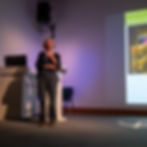Living with a Star - the Many Faces of our Sun, by Professor Sarah Matthews
- Mike Meynell
- Jan 15, 2024
- 3 min read
In an era where global challenges often overshadow less visible threats, Professor Sarah Matthews' lecture, "Living with a Star - the Many Faces of our Sun," brought to light the critical importance of understanding solar activity. Sarah, who is Head of Solar Physics at UCL's Mullard Space Science Laboratory, embarked on an enlightening journey through the dynamics of the Sun and its profound impact on Earth.

First up, though, making his debut in front of the Flamsteed audience, Manish Patel gave us a thoroughly enjoyable overview of recent space missions and a few things to spot in the night sky in the next few months. He spotlighted the successful landing of India's Chandrayann-3 on the Moon's South Pole, alongside the unfortunate failures of Russian and Japanese lunar missions. Manish also delved into significant ongoing missions like NASA's Psyche and the European Space Agency's JUICE mission to Jupiter. His discussion extended to the James Webb Space Telescope's insights into early galaxies and the forthcoming visibility of comets such as 62P/Tsuchinshan and 144P/Kushida. The talk wrapped up with anticipation for the upcoming total solar eclipse visible across North America. We extend our thanks to Manish for his engaging presentation and look forward to him becoming a regular presenter at our events.

Paul May then introduced Professor Sarah Matthews to the Flamsteed. Sarah began by unravelling the mysteries of the solar corona. She described this outer layer of the Sun's atmosphere as a spectacle of magnetic fields and charged particles, painting a picture of a vibrant and energetic solar environment. Her explanation delved into how observing the Sun in different wavelengths unveils various aspects of its atmosphere, each telling a unique story about solar phenomena.
The core of Sarah’s talk focused on the dramatic and powerful events of solar flares and coronal mass ejections. She also connected these colossal solar outbursts to tangible impacts on Earth, by discussing how these solar events could disrupt modern technology, from GPS systems to power grids. The reference to the Carrington Event of 1859 served as a stark reminder of our vulnerability to solar weather, emphasizing the lecture's relevance in today's technologically dependent world.
Sarah provided a detailed insight into the workings Hinode satellite, emphasizing its critical role in understanding solar phenomena. She explained how the satellite is utilised to study energy release events in the Sun's atmosphere. This is particularly crucial for understanding how high-energy particles, such as electrons and protons, are accelerated and escape into the heliosphere, potentially impacting satellite electronics and other space-based systems.

Sarah detailed the process of creating images with the EUV Imaging Spectromter (EIS). By moving a slit across the Sun's surface and stacking the resulting slit images, the instrument can produce spectrally pure images. This technique allows researchers to discern various ionization stages of elements like iron in the Sun's atmosphere. Such detailed spectral information is vital for determining the temperature, density, turbulence, and velocity of the solar plasma, providing deeper insights into the dynamic processes at play.
Furthermore, she highlighted the EIS's capability to measure the elemental composition of the Sun, which is primarily hydrogen and helium, with about 2% comprising other elements or “metals”. These elements produce spectral lines that are key to understanding the solar atmosphere. The data from EIS enable scientists to model the properties of the solar atmosphere, linking the observed solar phenomena to the material found in the solar wind and ultimately affecting Earth's magnetosphere.

Sarah’s conclusion was that the “standard” model of solar flares and coronal mass ejections has gaps, and there is much that we still need to learn. Though spectroscopy allows us to probe changes in the solar atmosphere that give us some advance notice that a flare is imminent, it is not enough notice to really help with space weather forecasting. For example, the National Grid in the UK would like 5 days of notice! If we had another Carrington Event, we would have less than a day to prepare. We are not making very rapid progress towards that 5-day target.
The lecture concluded on a forward-looking note, emphasizing the need for better space weather forecasting. The Solar-C mission is the successor to Hinode and will provide 7-times the spatial resolution in comparison to the Hinode mission. Sarah painted a picture of a future where enhanced understanding and technology could mitigate the risks posed by solar activities.

Sarah’s talk served as a reminder that in our fast-paced, interconnected world, understanding the nuances of solar activity is not just a scientific endeavour but a necessity for our continued progress and safety. We thank Sarah for her fascinating lecture and wish her all the best in her future research.





















